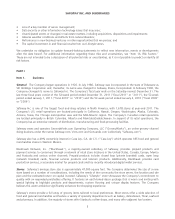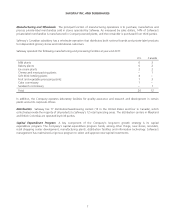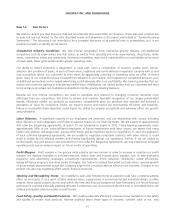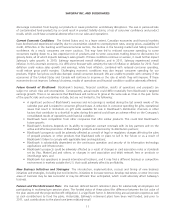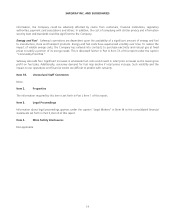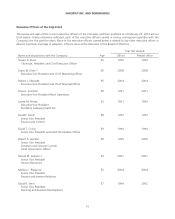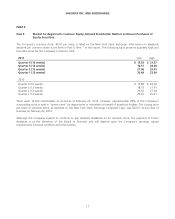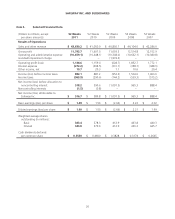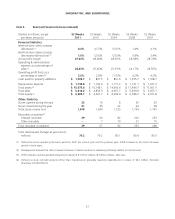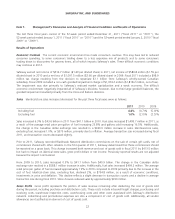Safeway 2011 Annual Report Download - page 30
Download and view the complete annual report
Please find page 30 of the 2011 Safeway annual report below. You can navigate through the pages in the report by either clicking on the pages listed below, or by using the keyword search tool below to find specific information within the annual report.SAFEWAY INC. AND SUBSIDIARIES
The decline in the financial markets during 2008 resulted in a substantial reduction in the fair value of the retirement plan
assets. Since 2008, the financial markets improved. Despite the improvement, the projected benefit obligation exceeded
the fair value of the plan assets. As a result, cash contributions to pension and post-retirement plans increased from
$17.7 million in 2010 to approximately $176.2 million in 2011 and are expected to be $160.0 million in 2012. If financial
markets do not continue to improve or if financial markets decline, increased pension expense and cash contributions
may have an adverse impact on our financial results.
In addition, we participate in various multiemployer pension plans for substantially all employees represented by unions.
We are required to make contributions to these plans in amounts established under collective bargaining agreements.
Under the Pension Protection Act of 2006 (“PPA”), additional contributions may be required in the form of a surcharge
that is equal to 5% of the contributions due in the first year and 10% each year thereafter until the applicable bargaining
agreement expires. If surcharges are required, many of our bargaining agreements provide for an offset against
contribution amounts otherwise required under those agreements.
Pension expense for these plans is recognized as contributions are made. Benefits generally are based on a fixed amount
for each year of service. We contributed $312.2 million, $292.3 million and $278.1 million to these plans in 2011, 2010
and 2009, respectively. Based on the most recent information available to us, a number of these multiemployer plans are
underfunded. As a result, contributions to these plans may increase. The amount of any increase or decrease in our
required contributions to these multiemployer pension plans will depend upon the outcome of collective bargaining,
actions taken by trustees who manage the plans, government regulations, the actual return on assets held in the plans
and the potential payment of a withdrawal liability if we choose to exit a market, among other factors. Additionally, the
benefit levels and related issues will continue to create collective bargaining challenges. Under current law, an employer
that withdraws or partially withdraws from a multiemployer pension plan may incur withdrawal liability, which is related
to the portion of the plan’s underfunding that is allocable to the withdrawing employer under very complex actuarial and
allocation rules. Multiemployer pension legislation passed in 2006 and 2008 will continue to apply to the funds in which
we participate, which may have an impact on future pension contributions.
Substantial Indebtedness We currently have, and expect to continue to have, a significant amount of debt, which
could adversely affect our financial health. As of December 31, 2011, we had approximately $5.4 billion in total
consolidated debt outstanding, including capital lease obligations. This substantial indebtedness could increase our
vulnerability to general adverse economic and industry conditions. If debt markets do not permit us to refinance certain
maturing debt: (i) we may be required to dedicate an unplanned portion of our cash flow from operations to payments
on our indebtedness, thereby reducing the availability of our cash flow to fund working capital, capital expenditures,
dividends on common stock, stock repurchases, acquisitions, development efforts and other general corporate purposes;
(ii) our flexibility in planning for, or reacting to, changes in our business may be limited; (iii) we might be placed at a
competitive disadvantage relative to our competitors that have less debt; and (iv) we may be limited by the financial and
other restrictive covenants in the documents governing our indebtedness. Changes in our credit ratings may have an
adverse impact on our financing costs and structure in future periods, such as higher interest costs on future financings
and our ability to participate in the commercial paper market. Additionally, interest expense could be materially and
adversely affected by increases in interest rates, increases in the amount of outstanding debt, decisions to incur premiums
on the early redemption of debt and any other factor that results in an increase in debt.
Unfavorable Changes in Government Regulation Our stores are subject to various federal, state, local and foreign
laws, regulations and administrative practices that affect our business. We must comply with numerous provisions
regulating health and sanitation standards, food labeling, energy, equal employment opportunity, minimum wages and
licensing for the sale of food, drugs and alcoholic beverages. We cannot predict either the nature of future laws,
regulations, interpretations or applications, or the effect either additional government regulations or administrative
orders, when and if promulgated, or disparate federal, state, local and foreign regulatory schemes would have on our
future business. They could, however, require the reformulation of certain products to meet new standards, the recall or
discontinuance of certain products not able to be reformulated, additional record keeping, expanded documentation of
the properties of certain products, expanded or different labeling and/or scientific substantiation. Any or all of such
requirements could have an adverse effect on our results of operations and financial condition.
12





